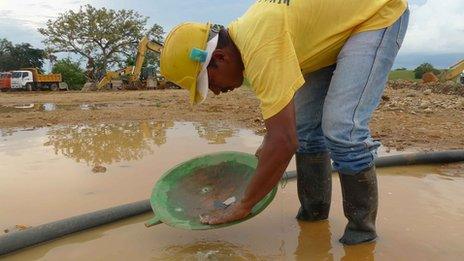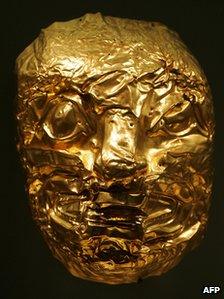South America sees new gold rush
- Published

Thousands have gone to the Amazon region in search of their fortune
From the vantage point of a trench, four soldiers watch as a Colombian military helicopter returns from an operation in the north-west of the country, an area known as the "red zone" where the illegal drugs trade is big business.
But the crew returning to the airport of Caucasia had not been on a raid to arrest drug dealers nor to destroy a coca plantation.
Their target was illegal gold mines.
Since the start of the global economic crisis in 2008, gold has risen in price by 100%, and in South America production of this precious metal is booming.
The impact of the price rise has been felt across nine countries in the region with workers migrating to mining areas and politicians striving to attract foreign investment for the mining industry.
Governments have also been forced to step up efforts to tackle illegal mining, amid fears that it is damaging the environment and creating lawless encampments where taxes are evaded and women sexually exploited.
Davidson Garcez: "All the areas explored 15, 20 years ago are being explored again"
The authorities in Colombia say an even more worrying development is that illegal gold mines are being used to support guerrillas from the Revolutionary Armed Forces of Colombia (Farc).
The Colombian government has long said that the drugs trade is a major source of income for the Farc but it appears that a tough anti-drugs policy has forced the rebels to seek alternative sources of income.
"Groups previously engaged in the production of coca are moving to another activity their territory allows: gold mining," says Carlos Medina, law and political science professor at the National University of Colombia.
Considered a safe investment in times of financial instability, gold has doubled in price since 2007 to around $1,600 (£1040) an ounce (31g), an attractive option for both legal and illegal traders.
In a speech in Caucasia last January, Colombian President Juan Manuel Santos said that eradicating illegal mining was as important as dealing with drug trafficking.
"It is a phenomenon that is happening across the region not only because of the high gold price but also because criminal groups have found a source of income and sometimes governments take too long to react," he said.
Sprawling camps
In Peru, the main gold producer in Latin America and the sixth biggest in the world, high gold prices have brought tens of thousands of migrants to the Amazon rainforest which contains vast reserves.
<itemMeta>news/world-latin-america-18328202</itemMeta>
Many have settled around the recently opened Interoceanic Road which links Brazil to Peruvian ports on the Pacific coast.
They are searching for gold around the Madre de Dios river and its tributaries.
Giovani Alves: "We have seen two gold booms before. We hope this one will be good"
The camps surrounding the mine sprawl along the highway for at least 50km (31 miles).
There are large areas of deforestation around the tents and reported high levels of mercury and cyanide pollution in the rivers.
Efforts by the Peruvian government to deal with this have led to clashes between miners and the security forces.
Across South America, governments are adopting a tougher approach.
In Brazil, 8,700 military personnel are being used, among other steps, to combat illegal gold mining along the borders with Venezuela, Guyana, Suriname and French Guiana.
Human anthill
The new gold rush in South America has also attracted regional and international mining companies.
With the latest technology and huge investment, they are reopening mines abandoned long ago.

South America's fabled gold riches gave rise to the legend of El Dorado
One such mine is Serra Pelada, in the Brazilian state of Para, which came to international attention in 1986 through the dramatic images of photographer Sebastiao Salgado.
Once considered the largest open-pit mining in the world, the Serra Pelada closed in 1992 when the depth of the remaining reserves made manual extraction too difficult and dangerous.
From 2013, however, gold will be extracted from Serra Pelada using heavy lifting machinery.
<link> <caption>Another mine to be reopened lies in Pilar de Goias,</caption> <altText>Yamana </altText> <url href="http://www.yamana.com/default.aspx?SectionId=32094ff7-ec1a-4f30-afc7-5d1c79df1a7a&LanguageId=1" platform="highweb"/> </link> a small town in the centre of Brazil which was founded in 1741 during the first gold rush in the country.
The mine, which is due to begin operating in mid-2013, is owned by the Canadian-based company Yamana, which expects to recover some 3.7 tonnes of gold a year.
As each tonne of rock contains only two grams of gold, it will have to be separated by a complex refining process.
Yamana says that its mining practices are guided by concern for the environment.
Local people would like the reopened mine to put an end to two centuries of decay in the area.
Former town councillor Giovani Alves hopes this time round the gold rush will bring lasting benefits.
He believes it is time the mineral wealth of South America was used to improve the lives of its people.
"It is the hour of our redemption," he said.
- Published5 June 2012
- Published14 March 2012
- Published14 March 2012
- Published22 November 2011